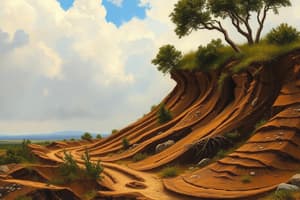Podcast
Questions and Answers
What is the primary consequence of soil erosion on agricultural productivity?
What is the primary consequence of soil erosion on agricultural productivity?
- It improves the fertility of the soil
- It enhances the biodiversity of soil organisms
- It leads to the loss of fertile soil (correct)
- It increases water retention in the soil
Which natural cause can lead to soil erosion through the movement of water?
Which natural cause can lead to soil erosion through the movement of water?
- Heavy rainfall causing surface runoff (correct)
- Volcanic activity modeling the landscape
- Plant roots stabilizing the soil
- Strong winds displacing topsoil
How does deforestation contribute to soil erosion?
How does deforestation contribute to soil erosion?
- By increasing soil nutrient levels
- By removing vegetation that anchors soil (correct)
- By exposing the soil to stronger winds
- By enhancing the growth of other plants
Which agricultural practice is a contributor to soil erosion?
Which agricultural practice is a contributor to soil erosion?
What impact does monoculture farming have on soil erosion?
What impact does monoculture farming have on soil erosion?
What role does gravity play in soil erosion on steep slopes?
What role does gravity play in soil erosion on steep slopes?
Which of the following methods can help control soil erosion?
Which of the following methods can help control soil erosion?
What is a potential result of urbanization related to soil erosion?
What is a potential result of urbanization related to soil erosion?
What is one benefit of afforestation and reforestation in controlling soil erosion?
What is one benefit of afforestation and reforestation in controlling soil erosion?
Which method involves planting crops during off-seasons to protect soil?
Which method involves planting crops during off-seasons to protect soil?
What is the primary purpose of creating terraces on steep slopes?
What is the primary purpose of creating terraces on steep slopes?
How do check dams and silt fences primarily prevent erosion?
How do check dams and silt fences primarily prevent erosion?
Which method of soil erosion control minimizes soil disturbance through farming techniques?
Which method of soil erosion control minimizes soil disturbance through farming techniques?
What is the purpose of mulching in soil management?
What is the purpose of mulching in soil management?
What is a function of drainage control in managing soil erosion?
What is a function of drainage control in managing soil erosion?
What does contour plowing do to minimize soil erosion?
What does contour plowing do to minimize soil erosion?
What is the primary benefit of rainwater harvesting in agricultural contexts?
What is the primary benefit of rainwater harvesting in agricultural contexts?
Which method is NOT part of the treatment options for contaminated soil?
Which method is NOT part of the treatment options for contaminated soil?
What is a major challenge associated with soil contamination in urban areas?
What is a major challenge associated with soil contamination in urban areas?
What role do micro-organisms play in bioremediation?
What role do micro-organisms play in bioremediation?
Which of the following contaminants can bioremediation effectively mitigate?
Which of the following contaminants can bioremediation effectively mitigate?
What is the potential drawback of using bioremediation for soil decontamination?
What is the potential drawback of using bioremediation for soil decontamination?
How does chemical oxidation treat contaminated soil?
How does chemical oxidation treat contaminated soil?
Which process involves the addition of immobilizing agents to soil?
Which process involves the addition of immobilizing agents to soil?
What is the primary purpose of chemical oxidation in soil treatment?
What is the primary purpose of chemical oxidation in soil treatment?
Which of the following contaminants can chemical oxidation treat?
Which of the following contaminants can chemical oxidation treat?
How does soil stabilization primarily reduce risks from contamination?
How does soil stabilization primarily reduce risks from contamination?
What does soil washing achieve in terms of soil treatment?
What does soil washing achieve in terms of soil treatment?
Why is soil remediation important?
Why is soil remediation important?
What is a significant benefit of Enva operating a licensed contaminated soil treatment facility?
What is a significant benefit of Enva operating a licensed contaminated soil treatment facility?
What does the addition of immobilizing agents in soil stabilization accomplish?
What does the addition of immobilizing agents in soil stabilization accomplish?
What is a major limitation of soil washing as a treatment method?
What is a major limitation of soil washing as a treatment method?
Flashcards are hidden until you start studying
Study Notes
Soil Erosion
- Soil erosion involves the removal of the topsoil layer by natural forces like wind and water, as well as human activities.
- Consequences include loss of fertile soil, agricultural productivity decline, and environmental damage.
- Erosion can lead to desertification, habitat loss, decreased soil water retention, and nutrient depletion.
Root Causes of Soil Erosion
-
Natural Causes:
- Water Erosion: Heavy rainfall causes surface runoff that dislodges soil; rivers erode banks and create gullies.
- Wind Erosion: Strong winds transport dry soil particles, especially in arid regions, causing dust storms.
- Gravity: Landslides and mudslides on steep slopes can rapidly shift large soil volumes, triggered by heavy rains or seismic activities.
-
Human-Induced Causes:
- Deforestation: Clearing vegetation for agriculture loosens soil, increasing vulnerability to erosion.
- Agricultural Practices: Overgrazing by livestock and monoculture farming degrade soil and make it prone to erosion. Improper plowing techniques exacerbate runoff.
- Urbanization: Construction exposes subsoils to erosion; urban runoff from impervious surfaces further accelerates erosion.
Methods of Controlling Soil Erosion
-
Vegetative Methods:
- Afforestation and Reforestation: Planting trees stabilizes soil through root systems and reduces erosive impacts.
- Cover Crops: Growing plants like clover or rye enhances soil structure and prevents erosion during off-seasons.
- Contour Plowing: Plowing along slopes decreases runoff speed and mitigates erosion.
- Terracing: Creating steps on sloped land reduces runoff velocity and aids water infiltration.
-
Structural Methods:
- Check Dams and Silt Fences: Barriers slow water flow and trap sediment, mitigating downstream erosion.
- Retaining Walls: Stabilize soil in landslide-prone areas and impede erosion.
- Riprap: Large stones on slopes absorb energy from water, protecting against erosion.
-
Soil Management Techniques:
- No-Till Farming: Preserves soil structure and minimizes erosion.
- Mulching: Protects soil surface from raindrop impact and retains moisture.
- Contour Bunding: Embankments along contours slow water flow and enhance infiltration.
-
Water Management:
- Drainage Control: Proper drainage systems reduce erosion risk by directing water away from vulnerable areas.
- Rainwater Harvesting: Reduces runoff and supplies water, alleviating erosion stress on soil.
Methods of Soil Treatment
- Soil contamination arises from improper management of hazardous substances, prevalent in urban areas and former industrial sites.
- Contaminants may be surface-applied or leaked into the soil from underground sources like tanks and pipes, potentially impacting groundwater.
Soil Treatment Techniques
- Bioremediation: Utilizes microorganisms to degrade or transform contaminants. Effective against hydrocarbons, various organic solvents, and metals.
- Chemical Oxidation: Involves injecting oxidants into contaminated areas, facilitating rapid contaminant destruction, ideal for difficult-to-access soils.
- Soil Stabilisation: Enhances safety by locking contaminants in place, improving soil structure for construction through immobilizing agents.
- Soil Washing: Cleans soil by separating contaminants using liquid solutions, necessitating careful disposal of residual contaminated materials.
Importance of Soil Remediation
- Essential for mitigating health risks associated with contaminated soil; procedures include testing, investigation, and treatment.
- Enva offers comprehensive soil remediation services, including the only licensed treatment facility in Ireland, which can reduce costs for soil management.
Studying That Suits You
Use AI to generate personalized quizzes and flashcards to suit your learning preferences.




